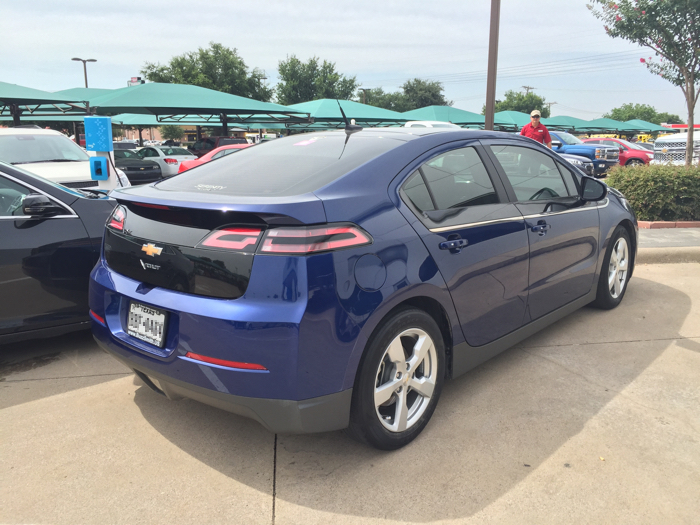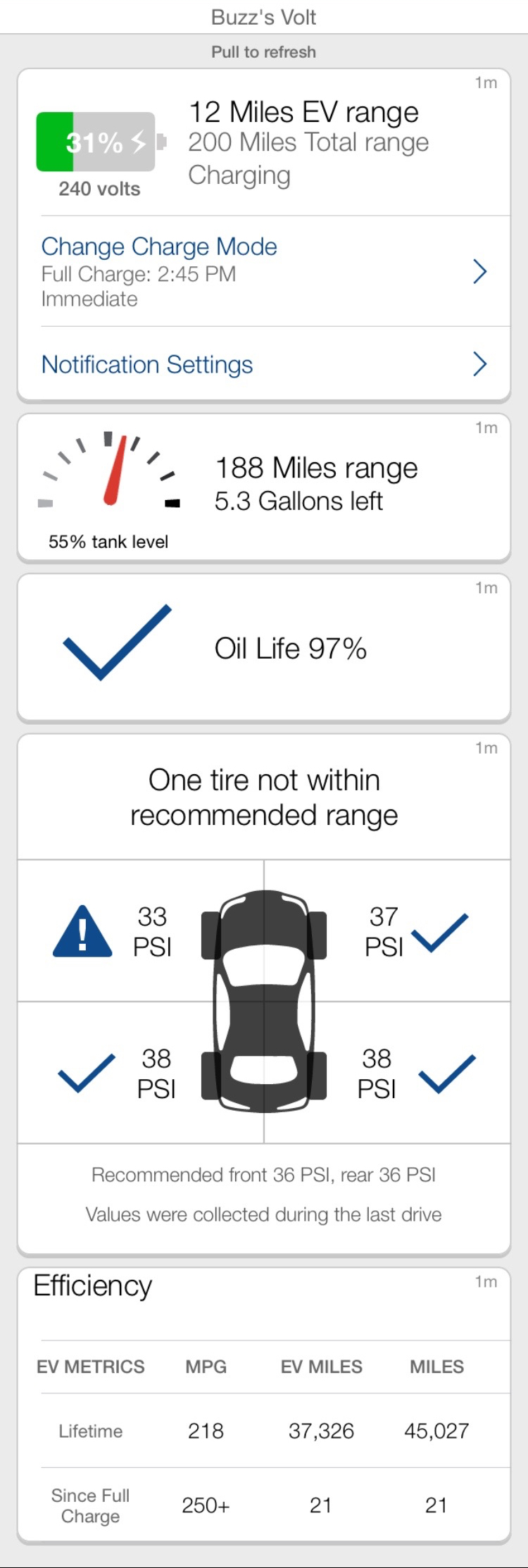 The day has finally arrived. The leasing company is coming by to examine my first Volt, in preparation for its return to them. I am surprised at the nagging background feeling of sadness that I have. This car changed my life! Seriously. I am now working at a Chevy dealership because of this car. We downsized our home and moved to a relatively undeveloped area, because of this car. I have had public speaking engagements, been interviewed on radio, TV and in newspapers, because of this car. I’ve become active with local government and civic groups, because of this car. But I thought that my excitement over getting a newly redesigned Volt would make me immune to this car’s charms, but like my first girlfriend, I think this one will live on in my mind for a very long time. My blue Volt’s final stats:
The day has finally arrived. The leasing company is coming by to examine my first Volt, in preparation for its return to them. I am surprised at the nagging background feeling of sadness that I have. This car changed my life! Seriously. I am now working at a Chevy dealership because of this car. We downsized our home and moved to a relatively undeveloped area, because of this car. I have had public speaking engagements, been interviewed on radio, TV and in newspapers, because of this car. I’ve become active with local government and civic groups, because of this car. But I thought that my excitement over getting a newly redesigned Volt would make me immune to this car’s charms, but like my first girlfriend, I think this one will live on in my mind for a very long time. My blue Volt’s final stats: I ended up being 83% electric, over the entire time I’ve had my Volt. Since my original estimate was 75%, I’m pleased with this. That means I used about 208 gallons of gasoline during the last three years/45,027 miles. In my previous car, (a Lexus ES300 that got 22MPG, which is the average MPG for new cars, in the U.S., today) I would have used 2,047 gallons! The Volt saved me from buying 1,839 gallons which, at the average price for gas over the last three years of $3.00 per gallon, represents a cost of $624.40 (or a savings of $5,516.00!!!). But what about the price of electricity? Yes, that must be taken into account. At 8.3¢ per kWh, 12.8 kWh for a full charge and about 40 miles per charge, that’s an additional cost of $991.38. So my total cost to go 45,027 miles was $1,615.78. That 2,047 gallons I would have bought in my previous vehicle would have cost $6,141. I saved $4,525.22 in fuel cost. Since I started working at the dealership, almost two years ago, I have been allowed to charge for free. This shifted a large portion of that $991.38 in electricity cost to my employer. Since not everyone can charge at work, we’ll pretend I paid for all electricity and go with the $4,525.22 savings.
I ended up being 83% electric, over the entire time I’ve had my Volt. Since my original estimate was 75%, I’m pleased with this. That means I used about 208 gallons of gasoline during the last three years/45,027 miles. In my previous car, (a Lexus ES300 that got 22MPG, which is the average MPG for new cars, in the U.S., today) I would have used 2,047 gallons! The Volt saved me from buying 1,839 gallons which, at the average price for gas over the last three years of $3.00 per gallon, represents a cost of $624.40 (or a savings of $5,516.00!!!). But what about the price of electricity? Yes, that must be taken into account. At 8.3¢ per kWh, 12.8 kWh for a full charge and about 40 miles per charge, that’s an additional cost of $991.38. So my total cost to go 45,027 miles was $1,615.78. That 2,047 gallons I would have bought in my previous vehicle would have cost $6,141. I saved $4,525.22 in fuel cost. Since I started working at the dealership, almost two years ago, I have been allowed to charge for free. This shifted a large portion of that $991.38 in electricity cost to my employer. Since not everyone can charge at work, we’ll pretend I paid for all electricity and go with the $4,525.22 savings.
What about maintenance savings? My previous car would have had at least nine oil changes over a three year period. My Volt needed only one oil change. At 35K miles, although the remaining oil life display was 60%, I freaked out and had an oil change. According to the remaining oil life display (97% remaining), I could have easily gone the full three years without an oil change. That’s about $360 in maintenance cost, raising the amount saved to $4,885.22.
What’s priceless to me is that, for 37,326 miles, I drove a zero emissions vehicle.
Fare well, Serenity. May you be as great a car for the next lucky owner as you were for me. I’ll never forget you.
**UPDATE**
A person who examines returned lease vehicles for U.S. Bank just examined my Volt. I was wondering how this would go. He advised me to remove the stickers from my hatchback window, which I did (to save the $40 removal fee). He also said everything else looked like normal wear and tear, so there are no charges, other than the $390 inspection fee originally set up, when I leased the Volt. Even the tires were in great shape! This was the last concern I had about leasing, and at least with U.S. Bank, it was relatively painless.
Our next Volt lease return will be in late December (just in time for the 2016’s arrival). That lease was with Ally Bank. I’ll let you know how that return goes when it’s done.

Nice, thanks for sharing, Buzz. Like you, 3 years (and 67,000 gasoline-free miles) ago a Topaz Blue Volt changed my life..and like you I’ve also reduced my personal gasoline consumption by around 90%. And ALSO like you, it led me to a new life as a consumer advocate (for all plug in cars). But I like to think that rather than the Volt just changing us, it enabled us to be catalysts for changing the world around us, for the better. Enjoy the fond memories of your first Volt, and enjoy your new 2016! And if you ever want see how a blue ’12 Volt being driven until the wheels fall off is doing, stop by any time! Best, -Mark, Drive Electric Cars New England
I look forward to seeing how far you go. Keep me posted!
Where will your car end up for resale? Does the bank sell it directly or put it in an auction?
What do you think it will sell for?
Has the battery degraded much? What’s the all electric range now?
Thanks!
P.S. Re oil changes, X miles or X months whichever comes first is B.S.? Only the miles count? I always suspected that the oil companies made up the part about the oil should be changed every so many months regardless of the miles driven.
I’m not sure. The original leases had high residual values, so the leasing companies are taking a bath on them. No one seemed to realize how the government incentives would affect resale values. Based on that, I do not expect them to ship it anywhere, but they may get a better bid from another local dealer’s used car department. We’ll have to wait and see…
The battery has not degraded at all. Even in the last month, I always got at least 38 miles predicted range and I drive in Sport Mode all the time. In the Autumn, the owner should be able to match my best: 53 ACTUAL miles on one charge.
Based on other used Volts I’ve seen, I expect it to be in the $16K-$17K range.
As for the oil changes: I adhere to the manufacturer’s scheduled maintenance. That being said, the only miles that count on oil changes are miles driven on gasoline. Otherwise, the gas motor is off and not using up oil life. I only put 7,701 gasoline-powered miles on it, in three years. So, even under the most stringent requirements, it only needed one oil change, and probably could have gotten by without even that.
No battery degradation at all in three years. That’s fantastic.
This three year real world experience with the Volt is the best advertisement for it there could be. I have posted a summary and a link to this page on a couple of other sites.
IMO it’s immoral not to buy a plug-in car now, new or used, if one can afford it. Why? Because we have an environmental crisis now, worse than expected:
http://www.huffingtonpost.com/lance-simmens/turn-up-the-heat-on-clima_b_7828020.html
They are such great deals they should be flying off the lots anyway.
Thanks for this post and for this great web site.
Marketing idea:
Paint, in large, tasteful lettering, on both sides of the car:
142 mpg(e)
That’s what I calculated, using $3 to convert the cost of the electricity.
Chevrolet should pay for the paint job, at the very least.
What’s the cost per “gallon” equivalent to “fill up” an electric car?
Nissan Leaf: 24kWh (current pack size, only 21.3kWh usable) * $0.083/kWh (estimated average electricity cost) = $1.99 / 84 miles (EPA estimated range) = $0.024 per mile
Average car: $2.88 per gallon (last weeks average cost of gasoline from the EIA) / 25.4 MPG = $0.1134 per mile
Leaf EV miles per ‘gallon’ = 0.024 / 0.1134 * $2.88 = $0.61
Chevy Volt: 16kWh * $0.083/kWh (estimated average electricity cost) = $1.33 / 38 miles (EPA estimated range) = $0.035 per mile
Average car: $2.88 per gallon (last weeks average cost of gasoline from the EIA) / 25.4 MPG = $0.1134 per mile
Volt EV miles per ‘gallon’ = 0.035 / 0.1134 * $2.88 = $0.88
I think that’s right.